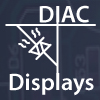The DIAC and Plasma Connection
Gas Discharge Breakover Conduction Technology
Plasma technology uses dischargeable gasses as breakover conduction switches. Helium, neon and xenon are well known dischargeable gases that exhibit breakover conduction. That is, when you apply a high voltage, the gas "breaks over" into a conductive glowing state. Neon signs, florescent bulbs and xenon flash bulbs all utilize breakover conduction.
In an AC plasma display, each pixel has a dischargeable gas disposed between a pair of dielectric-covered electrodes. Thus each pixel's capacitance limits the current flow during the plasma discharge. Plasma discharge characteristics are quite variable, more so than semiconductor breakover switches.
Parallelism Benefits DIAC Display Technology
The parallelism between plasma and DIAC display technologies allows a DIAC display to be operated with commonly used plasma display driving methods. The most common subfield driving method is Address-Display-Separated or ADS. It produces high-quality, full color, moving images. And, like every display device which contains sub-pixels for red, green and blue components, a DIAC display contains red, green and blue LEDs or OLEDs to emit visible light. By using the same driving method, a DIAC display can utilize large portions of a plasma display logic circuit.
Solid-State vs. Gas Discharge
Solid-stated electronic devices are designable to very tight specifications. As a result, the DIACs used in a DIAC display can be tuned to the display requirements. Gas discharge devices must be designed around the limitations of gas discharge physics and inherently require high voltage.
